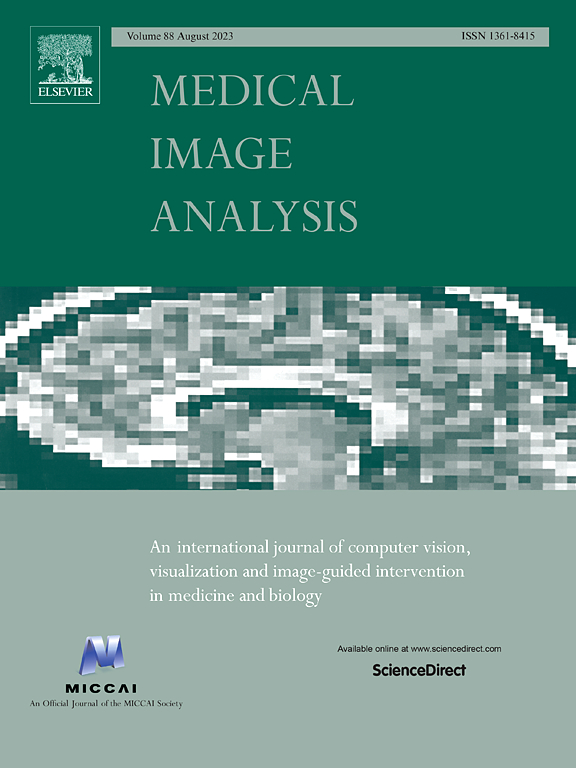自交互学习:计算病理学中分子性状预测的多尺度组织形态学特征的融合和进化。
IF 10.7
1区 医学
Q1 COMPUTER SCIENCE, ARTIFICIAL INTELLIGENCE
引用次数: 0
摘要
从组织形态学上预测疾病相关的分子特征为精准医学带来了巨大的机遇。尽管组织病理学图像中存在丰富的信息,但从标准整张幻灯片图像(WSI)中提取细粒度的分子特征是非平凡的。由于缺乏对可能跨越多个尺度的子类型和上下文组织形态学特征的注释,这项任务变得更加复杂。这项工作提出了一种新的多实例学习(MIL)框架,能够通过融合不同尺度的特征来进行基于wsi的癌症形态-分子亚型。我们的方法,作为Inter-MIL,遵循弱监督方案。它可以在任务感知优化过程中训练WSI的补丁级编码器,这一步通常在大多数现有的基于mil的WSI分析框架中没有建模。我们证明了优化补丁级编码器对于实现高质量的细粒度和组织级亚型结果至关重要,并且提供了对任务不可知编码器的重大改进。我们的方法部署了一个伪标签传播策略来迭代地更新补丁编码器,允许学习判别子类型特征。这种机制还允许在图像块(小块)中提取细粒度的注意力,这在大多数现有的基于弱监督的框架中基本上被忽略了。利用Inter-MIL,我们在卵巢癌、结直肠癌、肺癌和乳腺癌的背景下开展了四项具有挑战性的癌症分子分型任务。广泛的评估结果表明,在可用的训练幻灯片数量少于100的小数据集场景下,与最近提出的几种方法相比,Inter-MIL是一种强大的癌症形态-分子亚分框架,具有优越的性能。Inter-MIL的迭代优化机制显著提高了嵌入补丁学习的图像特征的质量,并通常将注意力图引导到与专家解释更一致的区域,从而识别出更可靠的组织病理学生物标志物。此外,通过外部验证队列验证了Inter-MIL在分子性状预测上的稳健性。本文章由计算机程序翻译,如有差异,请以英文原文为准。

Self-interactive learning: Fusion and evolution of multi-scale histomorphology features for molecular traits prediction in computational pathology
Predicting disease-related molecular traits from histomorphology brings great opportunities for precision medicine. Despite the rich information present in histopathological images, extracting fine-grained molecular features from standard whole slide images (WSI) is non-trivial. The task is further complicated by the lack of annotations for subtyping and contextual histomorphological features that might span multiple scales. This work proposes a novel multiple-instance learning (MIL) framework capable of WSI-based cancer morpho-molecular subtyping by fusion of different-scale features. Our method, debuting as Inter-MIL, follows a weakly-supervised scheme. It enables the training of the patch-level encoder for WSI in a task-aware optimisation procedure, a step normally not modelled in most existing MIL-based WSI analysis frameworks. We demonstrate that optimising the patch-level encoder is crucial to achieving high-quality fine-grained and tissue-level subtyping results and offers a significant improvement over task-agnostic encoders. Our approach deploys a pseudo-label propagation strategy to update the patch encoder iteratively, allowing discriminative subtype features to be learned. This mechanism also empowers extracting fine-grained attention within image tiles (the small patches), a task largely ignored in most existing weakly supervised-based frameworks. With Inter-MIL, we carried out four challenging cancer molecular subtyping tasks in the context of ovarian, colorectal, lung, and breast cancer. Extensive evaluation results show that Inter-MIL is a robust framework for cancer morpho-molecular subtyping with superior performance compared to several recently proposed methods, in small dataset scenarios where the number of available training slides is less than 100. The iterative optimisation mechanism of Inter-MIL significantly improves the quality of the image features learned by the patch embedded and generally directs the attention map to areas that better align with experts’ interpretation, leading to the identification of more reliable histopathology biomarkers. Moreover, an external validation cohort is used to verify the robustness of Inter-MIL on molecular trait prediction.
求助全文
通过发布文献求助,成功后即可免费获取论文全文。
去求助
来源期刊

Medical image analysis
工程技术-工程:生物医学
CiteScore
22.10
自引率
6.40%
发文量
309
审稿时长
6.6 months
期刊介绍:
Medical Image Analysis serves as a platform for sharing new research findings in the realm of medical and biological image analysis, with a focus on applications of computer vision, virtual reality, and robotics to biomedical imaging challenges. The journal prioritizes the publication of high-quality, original papers contributing to the fundamental science of processing, analyzing, and utilizing medical and biological images. It welcomes approaches utilizing biomedical image datasets across all spatial scales, from molecular/cellular imaging to tissue/organ imaging.
 求助内容:
求助内容: 应助结果提醒方式:
应助结果提醒方式:


